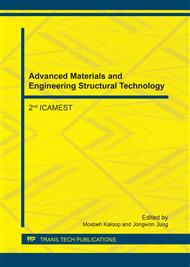p.42
p.48
p.54
p.59
p.65
p.71
p.78
p.84
p.89
Thickening Time Compatibility of Geopolymer Cement for Drilling Application
Abstract:
This paper investigates the composition of geopolymer cement for thickening time under elevated temperature and pressure. Geopolymer based-cement becoming popular in construction industries because of its improved properties either chemically and physically as compared to Ordinary Portland Cement (OPC). At the same time, replacement of OPC with geopolymer cement able to eliminate CO2 emission due to calcination burning process. However, applications of geopolymer cement to oil and gas industry for cementing job are not well recorded. Fly ash based geopolymer cement with different percentages of slag from 0% to 10% were mixed using sodium hydroxide and sodium silicate as alkali activators. Density, fluid loss and compressive strengths were determined. The sample were cured at 3,000 psi and 65°C for 24 hours. Results show that the addition of slag reduces the thickening time from 30 minutes to just only 18 minutes with almost 40% reduction in time. In terms of density and compressive strength, an increment of slag is directly proportional as the value increased from 14.3 ppg to 15.0 ppg for density and 1,120 psi to 2,155 psi for compressive strength. For fluid loss test, increment of slag results in decrement of fluid loss from 0.64 ml to just only 0.38 ml.
Info:
Periodical:
Pages:
65-70
Citation:
Online since:
April 2017
Keywords:
Price:
Сopyright:
© 2017 Trans Tech Publications Ltd. All Rights Reserved
Share:
Citation:


